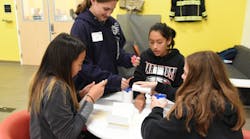It’s no secret that one of the manufacturing sector’s primary challenges is attracting talent to fill critical roles. With an aging workforce and increasing demand for advanced technology skills, it’s vital for manufacturers to interest youth in advanced manufacturing careers.
NextFlex, one of 14 Manufacturing USA Institutes, has a national mission to “build the next big thing” and foster advanced manufacturing innovation in crucial technology areas such as flexible hybrid electronics. One of the key components of this mission is education and workforce development.
NextFlex’s FlexFactor program brings together youth, educators and industry to tell the story of advanced manufacturing. The goal of the month-long, project-based learning program is to overcome common misconceptions that manufacturing jobs employ low-skilled workers for low wages.
“I thought working in a manufacturing career involved working in a cold, dark factory on an assembly line,” explained San Jose High School senior and FlexFactor alumna Alexandra Masegian.
Masegian wasn’t alone in her thinking—her classmates, teachers, guidance counselors and parents shared similar views. Through their participation in Flexfactor, however, they discovered career opportunities through an experience that involved gleaming classrooms, advanced robotic systems, supply chain management complexities and the creation of amazing products.
NextFlex has spent the past two years building, scaling and expanding the FlexFactor program in partnerships with high schools and community colleges around the country. Students participate in research, product design and customer discovery work, developing business models and products that they pitch to a group of professionals in a “Shark Tank”-style setting.
They also participate in two field trips. First, they visit a manufacturing company, where they discover what it’s like to work in the sector. Then they head to a college or university, where they learn about the education pathways that will prepare them for careers in advanced manufacturing.
Creating Value for Educators and Manufacturers
Early in 2018, Lorain County Community College near Cleveland, Ohio launched a FlexFactor pilot program. The program grew quickly--from 17 to over 700 students at area high schools.
“When you connect students to business and industry mentors, show them relevant career and education pathways, and allow them to use new technology and the entrepreneurial spirit to solve real-world problems, you get to witness a classroom light up,” said Deanna Strauss Hersko, the local FlexFactor program manager.
The Boeing Company recently partnered with NextFlex and the Alabama Community College system to bring FlexFactor to schools in Northern Alabama, where Boeing's manufacturing operations require a variety of technician and technologist talent. Boeing considers this an investment in the creation of local talent for their future workforce—and part of its community outreach as well, as students learn about fulfilling careers that they might not otherwise have exposure to.
Boeing and other industry participants describe FlexFactor’s effectiveness as twofold:
First, the program’s student-led learning approach harnesses innate curiosity and allows participants to learn about STEM through topics that are meaningful to them. And second, the program requires that students go through a rigorous deductive process to arrive at an informed answer rather than progressing through pre-determined lessons built around a series of end results.
By connecting academic activities to the real world, students are building important creative reasoning and critical thinking skills that manufacturers like Boeing want to see in future employees, while transforming students from passive observers to engaged evangelists for the manufacturing sector.
The Path Ahead
Ms. Masegian, mentioned earlier, has become one of those evangelists.
“The most impactful part of the FlexFactor program was the exposure to manufacturing careers,” she said. “Before I got to tour Jabil’s Blue Sky Center, I thought manufacturing was boring. After I went to Jabil and we saw all the products they make, it really opened my eyes, and the eyes of all my classmates, to a career we hadn’t considered before but now most of us want to go into.”
This is the kind of positive change in perception that makes an impact—and drives us to double down on our mission to reach the next generation.
When we bring together manufacturers, educators, students and parents and show them what’s possible with advanced manufacturing, we change our future. We empower an industry to create the changes needed for success and we inspire students to pursue rewarding careers in the critical high-tech manufacturing jobs of the future. This is the kind of innovation and large-scale collaboration that can truly transform our country.
Brynt Parmeter is director of workforce development, education and training at NextFlex. Emily McGrath is deputy director.




